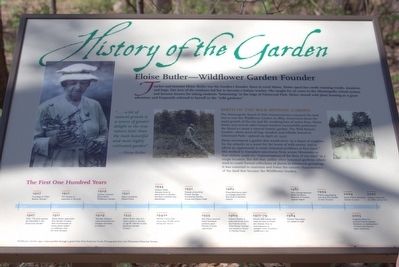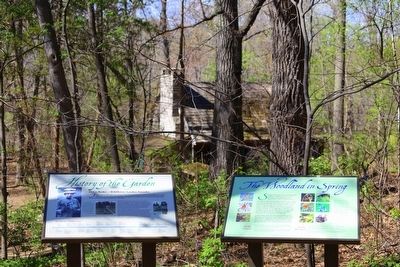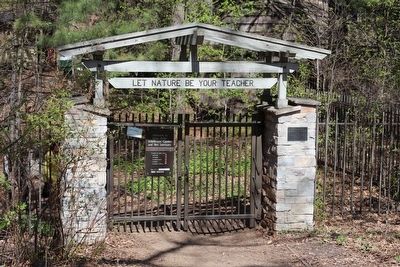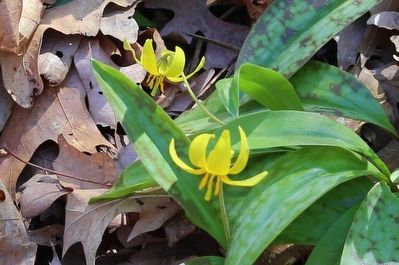Calhoun Isles in Minneapolis in Hennepin County, Minnesota — The American Midwest (Upper Plains)
History of the Garden
Eloise Butler—Wildflower Garden Founder
Teacher and botanist Eloise Butler was the Garden's founder. Born in rural Maine, Eloise spent her youth roaming woods, meadows and bogs. Her love of the outdoors led her to become a botany teacher. She taught for 36 years in the Minneapolis school system and became known for taking students “botanizing” in the bogs of Glenwood Park. Eloise viewed wild plant hunting as a great adventure and frequently referred to herself as the “wild gardener.”
Birth of the Wild Botanic Garden. The Minneapolis Board of Park Commissioners acquired the land that is now the Wildflower Garden in 1889. Concerned about the rapid growth of the city and the resulting loss of native flora, Eloise Butler and several other botany teachers successfully petitioned the Board to create a natural botanic garden. The Wild Botanic Garden—three acres of bog, meadow and hillside fenced in Glenwood Park—opened on April 27,1907.
Eloise envisioned a garden that would serve “as a depot of supplies for the schools; as a resort for the lovers of wild nature; and to afford an opportunity to study botanical problems at first hand.” She worked to transplant specimens from across Minnesota so that visitors could see “representatives of the flora of our state” in a single location. She felt that, unlike other botanical gardens, which tend to create formal collections of plants in unnatural groupings, it was essential to maintain and foster the natural characteristics of the land that became the Wildflower Garden.
The First One Hundred Years.
1907—Founding of “Wild Botanic Garden”
1907—Over 170 plants species are identified in the three-acre garden
1911—Eloise Butler appointed first Garden Curator. Tens of thousands of native plants added to collection over the next 20 years.
1912—The Garden is expanded to 20 acres
1929—Garden renamed Eloise Butler Wildflower Garden
1929—Tornado destroys many tamaracks and changes character of wetland
1932—Eloise completes Mallard Point
1933—Eloise Butler dies of a heart attack in Garden at age 81. Martha Crone becomes a Curator
1940s—Martha Crone adds more than 42,000 during her tenure
1944—Clinton Odell donates funds to add prairie to Garden. Northern wetland area abandoned
1952—Friends of the Wild Flower Garden founded by Martha Crone and Clinton Odell
1959—Ken Avery assumes
Head Gardener position upon Martha Crone’s retirement
1965—Prescribed burns are used to manage prairie for first time in Garden’s history
1969—Visitors Shelter is built with funds from the Friends of the Wild Flower Garden and named in honor of Martha Crone
1977–79—Almost 200 mature elm trees are lost to Dutch elm disease. Due to over-exposure to sunlight, many woodland wildflowers die
1984—Garden Naturalists are added to staff
1987—Cary George becomes Head Gardener. Removal of invasive species begins
1994—Prairie expanded by one acre. The Garden is now 15 acres
2004—Susan Wilkins become Garden Curator
2005—Ongoing efforts to remove invasive species. Emphasis on development of native and historic collections
2007—Garden celebrates its 100th anniversary
Erected by the Wildflower Garden. Made possible through a grant from First American Funds.
Topics. This historical marker is listed in these topic lists: Environment • Horticulture & Forestry. A significant historical month for this entry is April 1791.
Location. 44° 58.479′ N, 93° 19.319′ W. Marker is in Minneapolis, Minnesota, in Hennepin County. It is in Calhoun Isles. Marker can be reached from Theodore Wirth Parkway just south of Glenwood Avenue
. Touch for map. Marker is at or near this postal address: 1 Theodore Wirth Pkwy, Minneapolis MN 55422, United States of America. Touch for directions.
Other nearby markers. At least 8 other markers are within 2 miles of this marker, measured as the crow flies. Victory Memorial Drive (approx. ¼ mile away); Peavey Fountain (approx. 1.2 miles away); The Basilica of Saint Mary (approx. 1.8 miles away); Old Fort Snelling (approx. 1.8 miles away); The Woman's Club of Minneapolis (approx. 1.9 miles away); The Chain of Lakes (approx. 1.9 miles away); Minnesota World War I Marine Corps Memorial (approx. 2 miles away); In Memory of the Boys of Our Navy (approx. 2 miles away). Touch for a list and map of all markers in Minneapolis.
More about this marker. The marker is in the garden. There is no charge to enter the garden but the city street parking fee applies to its parking lot. There is a walking path to the garden from the Wirth Beach stop of the No. 9 Glenwood Avenue bus. It is a pleasant 7 minute walk from the bus stop to the garden’s main entrance. The garden closes one hour before sunset.
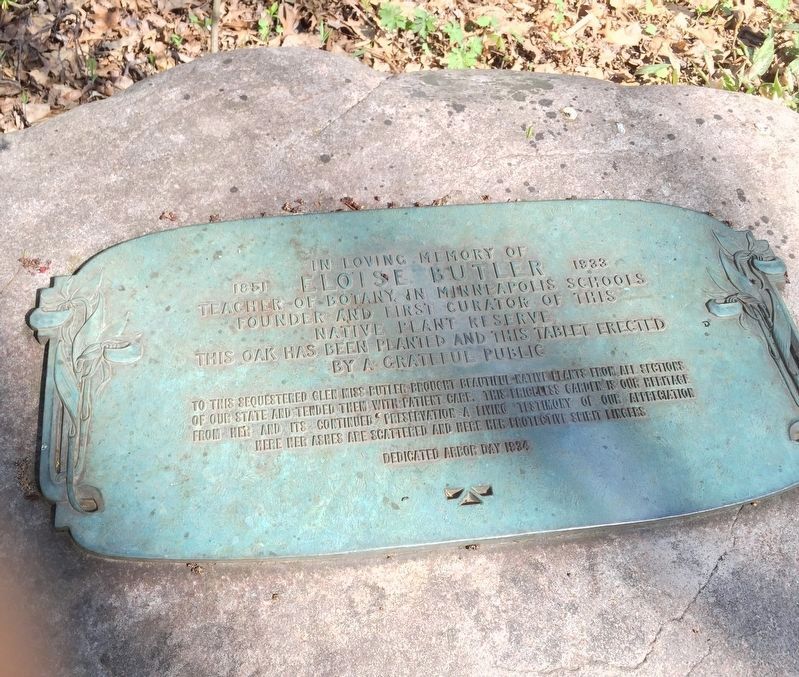
Photographed By Phyllis Prats, April 29, 2015
5. In Loving Memory of Eloise Butler (1851–1933)
Teacher of botany in Minneapolis Schools, founder and first curator of this native plant preserve. This oak has been planted and this tablet erected by a grateful public.
To this sequestered glen Miss Butler brought beautiful native plants from all sections of our state and tended them with patient care. This priceless garden is our heritage from her and its continued preservation a living testimony of our appreciation. Here her ashes are scattered and here her protective spirit linkers.Dedicated Arbor Day 1934.
Credits. This page was last revised on February 12, 2023. It was originally submitted on August 7, 2015, by J. J. Prats of Powell, Ohio. This page has been viewed 366 times since then and 7 times this year. Photos: 1, 2. submitted on August 8, 2015, by J. J. Prats of Powell, Ohio. 3, 4. submitted on August 9, 2015, by J. J. Prats of Powell, Ohio. 5. submitted on February 7, 2021, by J. J. Prats of Powell, Ohio.
